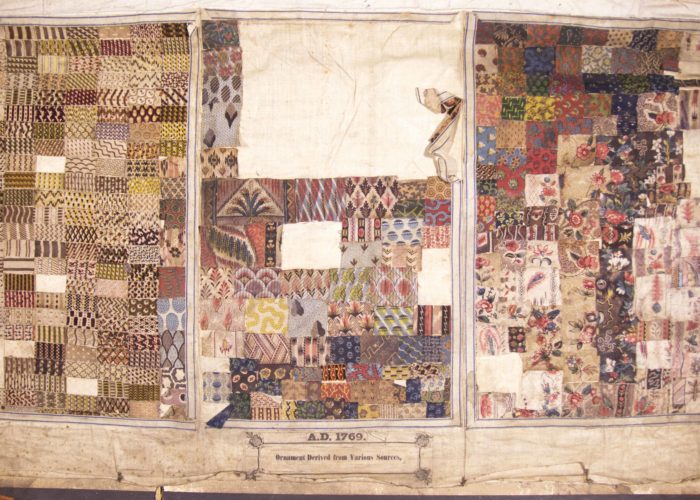Textile sample books
Theme: The impact of industry, Economic and technological revolution
Cotton was one of the latest textile fibres to be introduced to Britain as a raw material within a manufacturing system, but between the eighteenth and nineteenth centuries it rose to prominence as a cornerstone of the British economy. Cotton manufacture stimulated industrialisation, global commercial influence, and new communities of labour. This is one of five early sample books illustrating the cotton and calico designs produced by the textile industry in Salford between 1769 and 1851.
Britain had long manufactured and exported textiles. For centuries it was renowned for its fine woollens, and flax (the raw material worked into linen) also grew well in the damp climate. Linen and wool were used to make the linsey-woolsey worn by all but the richest people in the Middle Ages and Renaissance. Silk was next introduced by French Protestant silk workers fleeing persecution in the 17th century, mostly in London. But cotton, imported from the East Indies and later the Southern states of America, was a revolutionary introduction. The technological developments that made its processing quicker and more cost effective from the late 18th century allowed Britain to produce high qualities as well as large volumes of cheap and durable clothing.
Sample books collated by manufacturers and retail businesses were a means of showcasing the skills of the textile workers to potential buyers, who would browse the miniature patterns. Historically such designs were woven into the cloth, but for some textiles, including cotton, block printing (pressing of a pattern onto the fabric) was achievable.
In the final third of the 18th century, machines were developed and patented in Britain that used engraved plates and rollers to create more elaborate and precise patterns at great speed – creating a growing demand for imports of raw cotton and exporting these fabrics (known often as “chintz” or “calicos”) to markets all over the world. The simple pattern book, then, represents a microcosm of sweeping changes in how fabrics were grown, processed, and sold – and in a way, offer a forerunner to the sorts of online marketing and digital printing familiar to us today.
Did you know..?
These samples were displayed in one long strip at the Great Exhibition of 1851 at Crystal Palace in London, measuring 120 metres long (about the length of a football pitch).
Use our Classroom resources to investigate this object, the Industrial Revolution and Arts in the Age of Revolution further.
Highlights:
- Using objects, artworks and other sources to find out about the past
- How to design a quilt using digital collaging
- Mystery objects
- How to make a revolutionary stop-frame animation
And much more…
Sources & acknowledgements
This object description and its related educational resources were researched and written by our team of historians and education specialists. For further information see the item’s home museum, gallery or archive, listed above.
-
Did you know..?
These samples were displayed in one long strip at the Great Exhibition of 1851 at Crystal Palace in London, measuring 120 metres long (about the length of a football pitch).
-
Education overview
You can access a range of teachers resources related to this object and more on our education page.
Please also see our glossary of terms for more detailed explanations of the terms used.
-
Curatorial info
- Originating Museum: Salford Museum & Art Gallery
- Production Date: 1769-1851
- Material: Printed calico
- Size: 1030 mm X 630 mm X 65 mm
- Original record
-
Use this image
You can download this image for personal and educational use but please take note of the license type and rights holder information.
- Rights Holder: Salford Museum & Art Gallery
- License Type: All Rights Reserved





